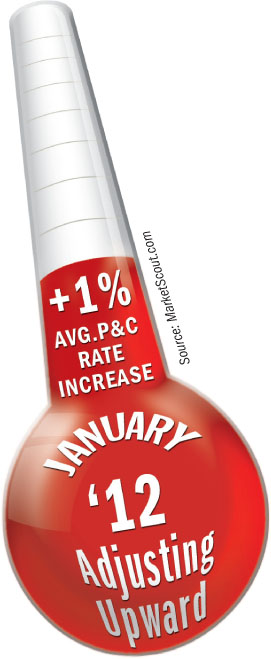 Catastrophe losses in 2011 led tothe U.S. P&C industry's largest underwriting loss since 2002,according to A.M. Best. And while the latest MarketScout barometershows that 2012 began with another month of commercial-lines rateincreases, Best maintains that a true hard market is likely “atleast a year or two away.”
Catastrophe losses in 2011 led tothe U.S. P&C industry's largest underwriting loss since 2002,according to A.M. Best. And while the latest MarketScout barometershows that 2012 began with another month of commercial-lines rateincreases, Best maintains that a true hard market is likely “atleast a year or two away.”
In a Feb. 6 special report on the U.S. P&C industry's 2011results, Best says $44.1 billion in catastrophe losses for the yearhelped drive net income down 49.2 percent to $21.9 billion. In2010, industry net income was $43.1 billion and catastrophe lossestotaled $19.6 billion.
|Underwriting losses are expected to total approximately $33.9billion for 2011—the second consecutive year of underwriting lossesand the third-largest annual-underwriting loss ever, behind 2001($56.4 billion) and 2002 ($34.3 billion).
|The industry's 2011 combined ratio climbed 6.5 points to 107.5.Catastrophe-related losses accounted for 10.1 points, compared to4.6 points in 2010. Reserve releases shaved 2.7 points off of the2011 combined ratio, down from three points from reserve releasesin 2010.
|Best says it expects the impact of reserve releases to lessengoing forward: “While there are select lines where reservingstrength remains, A.M. Best continues to believe the overallindustry's previous reserve cushion is largely exhausted because ofsizable reserve releases over the past six calendar years.”
|The ratings agency adds, “With overall industry-reserveredundancies expected to continue through 2012, albeit to a lesserextent, the overall reserve deficiency will continue to increase,and core, undiscounted reserves will remain inadequate.”
|Despite the challenges in 2011, the industry's policyholders'surplus declined only 1.4 percent to $562.7 billion, Best says. In2010, policyholders' surplus stood at a record $570.4 billion.
|Additionally, the industry saw net-premiumswritten increase 3.5 percent to $442 billion.
|“While the overall U.S. P&C industry demonstrated itsresiliency yet again in 2011 and remains well capitalized, theyear's results—and expectations for 2012—will vary by segment,”Best adds.
|Looking ahead to 2012, Best says pricing continues to improve inpersonal lines and in catastrophe-exposed property accounts, butsome commercial lines are still “fundamentally underpriced, and thesegment continues to be negatively impacted by weak macroeconomicconditions and decreasing reserve-adequacy levels.”
|According to online-insurance exchange MarketScout's latestmonthly Market Barometer, commercial lines did see positive ratemovement in January, as rates crept up by 1 percent.
|“The 1 percent composite increase in January matched theincrease for December 2011,” says MarketScout CEO Richard Kerr.“Workers' Compensation and Catastrophe Exposed Property continuedto exhibit the largest increases with upward adjustments of 2percent.”
|By coverage class, all lines were up or flat, similar toDecember.
|Business Interruption, which was up 1 percent in December, wasup 2 percent in January. Umbrella/Excess and Commercial Auto wereboth flat in December and were up 1 percent in January.
|Workers' Comp still showed upward momentum in January, but notas much as in December. Rates were up 2 percent in January for thisline compared to 3 percent in the month prior.
|By coverage class, small accounts were up 1 percent, down from 2percent in December, while medium accounts were up 2 in Januarycompared to 1 percent in December.
|Large accounts were unchanged (up 1 percent), while jumboaccounts remained flat on a month-to-month basis.
|Responding to the MarketScout survey, Meyer Shields, a financialanalyst with Stifel Nicolaus, says in an analyst's note, “We seeinsurers' deteriorating calendar-year results as the primarycatalyst for rate increases, and we expect these increases toaccelerate as favorable-reserve development subsides.”
|Despite the rate increases, and an expectation that 2012 willsee improved operating performance, Best says in its report that atraditional hard market is still a ways off. Best says insurers“still face a challenging environment, with relatively weakunderwriting results and lackluster investment returns expected toinfluence operating results over the next year.”
|Best says its outlook for commercial lines remains negative,while personal lines and U.S. reinsurance are stable.
Want to continue reading?
Become a Free PropertyCasualty360 Digital Reader
Your access to unlimited PropertyCasualty360 content isn’t changing.
Once you are an ALM digital member, you’ll receive:
- All PropertyCasualty360.com news coverage, best practices, and in-depth analysis.
- Educational webcasts, resources from industry leaders, and informative newsletters.
- Other award-winning websites including BenefitsPRO.com and ThinkAdvisor.com.
Already have an account? Sign In
© 2024 ALM Global, LLC, All Rights Reserved. Request academic re-use from www.copyright.com. All other uses, submit a request to [email protected]. For more information visit Asset & Logo Licensing.








